The essential guide to preparing for the construction loan funding process
Are you considering starting property development and investing? If so, you’ve likely considered how to fund your project. For many investors and developers like yourself, construction loans can provide the financial backing needed to get started on a new building project or renovate an existing property.
However, applying for a loan and getting approved can be more complicated than one might anticipate. To navigate this process with ease, we have assembled a guide of everything you need to know about preparing for the funding process associated with construction loans — from understanding eligible properties & costs to budgeting, planning, and loan closing!
Keep reading for all the details!
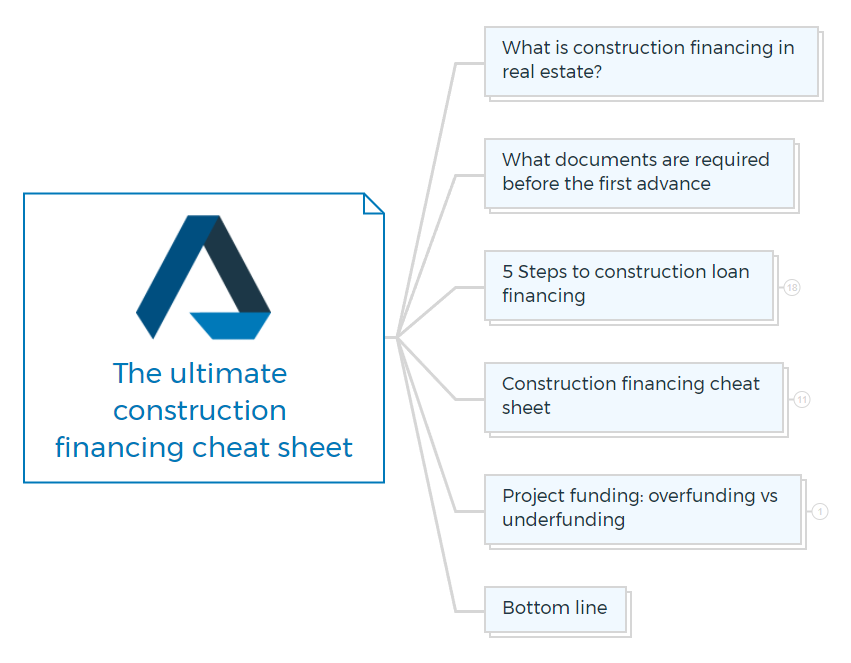
What is construction financing in real estate?
Construction financing in real estate is the process of obtaining a loan from a financial institution or lender to fund the development and construction of a property. This type of financing can be used to fund projects ranging from single family homes, condominiums, townhouses and other residential properties, commercial buildings such as office complexes, industrial warehouses and retail spaces, or even certain types of infrastructure projects.
The loan is typically secured against the real estate project itself, meaning that it can be used to cover costs associated with acquiring the land, construction materials, equipment and labor costs associated with building or rehabilitating a property.
Construction financing can provide borrowers access to capital needed for development and construction that may not otherwise be available or may be difficult to access through traditional financing sources.
What documents are required before the first advance
The following set of documentation and data is often necessary before the first construction financing advance, which typically happens at or soon after the loan closing:
- The agreement between the property developer and the construction manager or general contractor.
- Budget.
- A complete set of specifications and plans.
- Worker's compensation certificates.
- Certificates of current liability insurance from the developer and subcontractors
- Licenses for any trade that the municipality demands.
- A duplicate of the developer's certificate of builder's risk insurance.
- Copies of the general contractor's and the key subcontractors' surety bonds, if applicable, for the entire project.

Get The Edge Now!
Discover the transformative power of our FREE EDGE platform and
unlock a world of opportunities at no cost!

Your Real Estate Toolkit Awaits!
Free eBooks, Courses & Feasibility Suite Trial—Join Today!
✓ Unlimited FREE Trial: Experience the full power of our Feasibility Suite with hands-on demos
—explore without limits, no time pressure & without commitment or credit card!
✓ Learn from Success: Dive into real-life case studies for practical insights.
✓ Engage, Inquire, and Innovate: Ask questions, request features, and engage in lively discussions.
✓ Showcase Your Projects and Gain Insights: Share your projects and get personalised feedback.
✓ Free Resources Galore: Access a treasure trove of free resources,
eBooks & courses to keep you informed.
✓ Exclusive Training: Enjoy members-only training to sharpen your skills.
5 Steps to construction loan financing
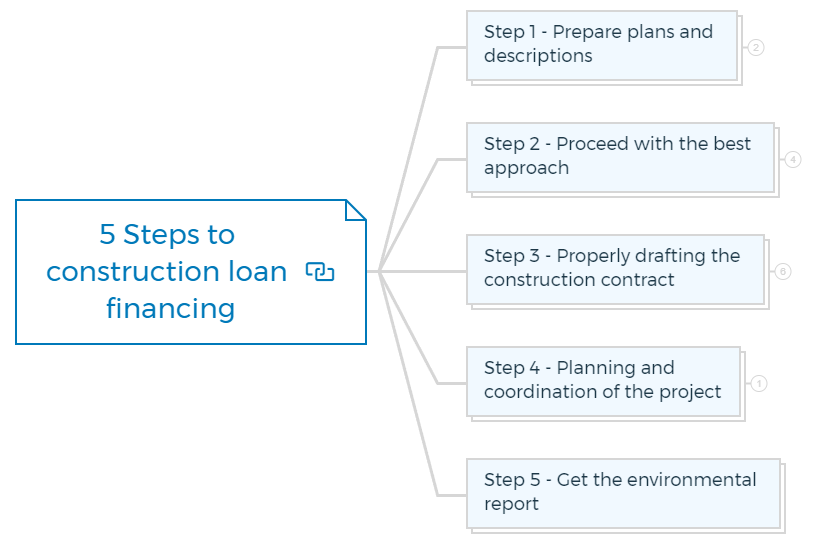
Step 1 - Prepare plans and descriptions
Every lender and the lender's engineering consultant should receive a set of plans and specifications for each construction loan.

Plans
Plans are basically the drawings. The most helpful ones to a lender are weighed and placed on sizable sheets of paper. All schematics are not to scale, but others, including those, are utilized in combination.
Working scales change based on the level of information required and the project component being considered. One-quarter inch equals one foot, and three-eighths of an inch equals one foot are the most used scales.
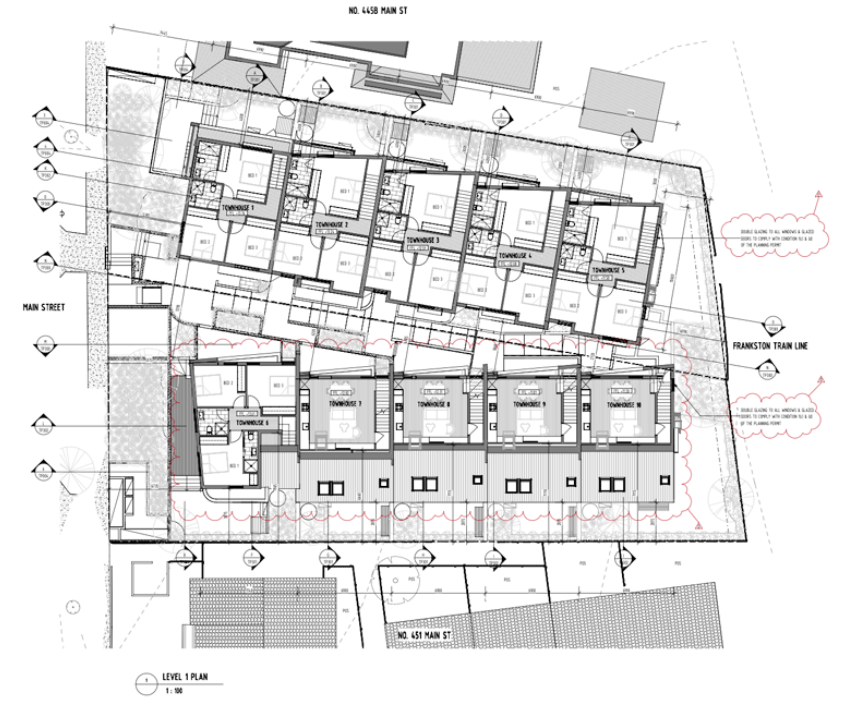
Plans must be precise and in-depth because you will use them to build the project.
Various sets of plans are available based on the intended use.
- Architectural plans that outline the project's layout and structure.
- Electrical plans that outline the project's wiring, lighting, electrical panels, and other components
- Heating, ventilation, and air conditioning (HVAC) plans
- Sprinkler and standpipe plans plumbing plans
- Elevator plans
- Demolition plans
- Excavation plans
They are indexed according to type in the lower right corner.
Specifications
Plans always have specifications. They can be printed out on paper the same size as the plan drawings or, on more significant projects, they are sometimes maintained in a separate book.
Plans offer a visual roadmap for how to continue, whereas specifications specify the tools and techniques needed in writing.
When you request a buildable or comprehensive set of blueprints, you also request specifications. Specifications must accompany plans if they are helpful for anything other than a broad initial conceptual approach.
An organization system is crucial because requirements can be several hundred pages long. An industry organization called the Construction Specifications Institute (CSI) has modified a standard system.
The system divides specifications into divisions, and each is further divided into subdivisions. Five-digit codes are used to identify the divisions; the first digit (or the second after a zero) designates the division, while the remaining digits designate subdivisions.
Learn More
Step 2 - Proceed with the best approach
A property developer can plan and construct a project using one of four fundamental, accepted approaches. These approaches overlap and aren't inseparable.
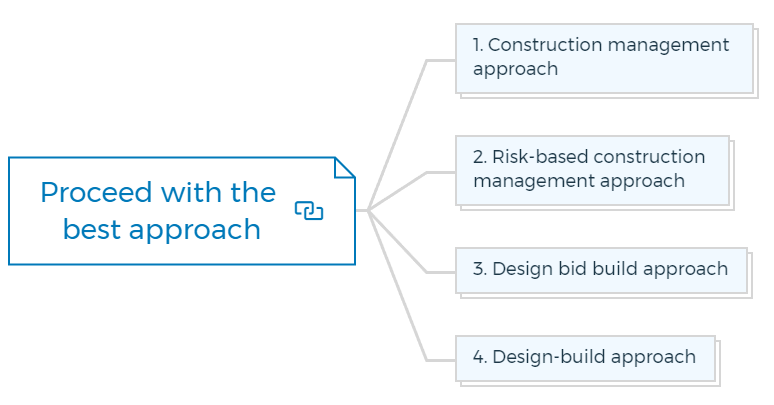
1. Construction management approach
The most well-known method involves the architect being engaged by the developer and producing a set of biddable blueprints and requirements. The owner's construction manager distributes designs and specifications to bidders.
Winners are selected based on cost, expertise, performance history, accessibility, and references. The owner and the contractors enter into contracts.
The architect stays actively involved in the construction phase by supervising the work through ongoing communication with the management or contractor and regular progress checks. The developer supports cost overruns with this approach.
2. Risk-based construction management approach
The only difference between this strategy and the construction management strategy is that the general contractor assumes the role of independent construction manager in it.
The general contractor's contract will cover budget overruns brought on by necessary change orders because it has greater control over the project.
The developer, who actively participates in the project's design, hires the architect in both the construction management and construction management at-risk approaches.
3. Design bid build approach
In contrast to the previous approach, the architect is also the construction manager in this one. The architect has the most control in this method, but due to the nature of the business, the developer is typically responsible for the cost overruns.
The architect may have too much power under the design-bid-build methodology. The developer may have significant overruns that are challenging to justify if there is insufficient outside control and he is not proficient in all facets of the architectural and construction management procedures.
As a result, it is the least used technique in commercial real estate construction.
4. Design-build approach
The design-build method is quickly gaining favour because, when done right, it shortens the time needed to start and finish a development project, offers more flexibility on-site, and lowers upfront expenses.
The developer, architect, and general contractor collaborate on the conceptual design of a design-build project, but the architect answers to the general contractor rather than the owner. The contractor must pay for cost overruns.
The design-build method enables simultaneous progress of all three steps, in contrast to the construction management and construction management at-risk techniques, which perform design, bid, and work activities linearly.
Before completing all project designs and requirements, the general contractor will start working (plans and specifications will be filed with all the applicable municipalities in stages). The project is finished sooner since tasks are carried out in parallel instead of serially.
Step 3 - Properly drafting the construction contract
Before a building contract is created in its final form and signed, there may be a lengthy procedure, except for easy, routine, or minor work. The sequence of events typically follows something like the description below.
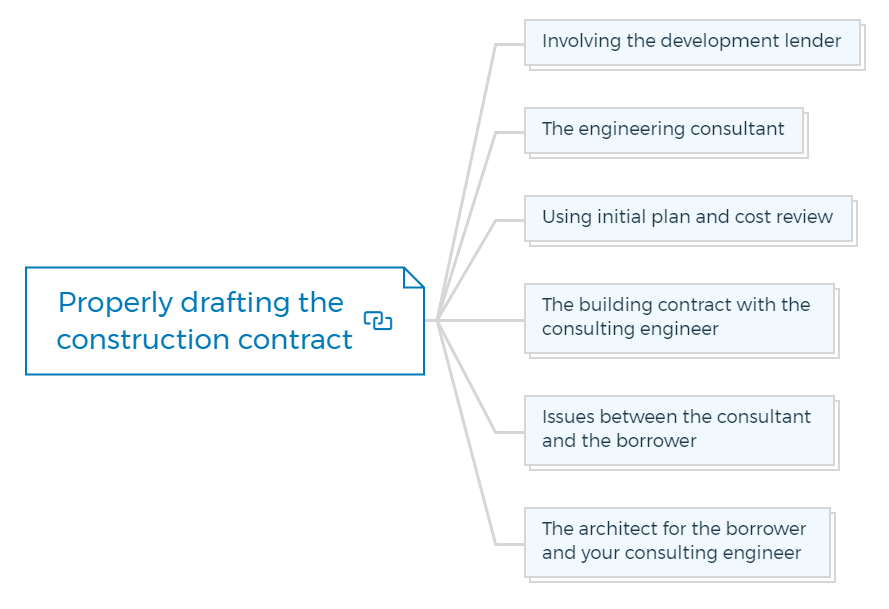
Involving the development lender
The developer should supply the lender and the lender's consultant engineer with the information required to evaluate the development project while their team is revising plans and specifications and reviewing, hiring, and contracting trades.
The engineering consultant
The consulting engineer is one of the tools the development lender uses (also called the inspecting engineer, engineer, construction consultant, or engineering consultant). Based on prior experience, senior management at most institutions compiles a short list of approved engineers from which the loan officer may select.
On a transaction-by-transaction basis, the outside consultant is chosen from the list. There may be an internal engineer who is in charge of examining the work of the external consulting engineer and overseeing their is performance in significant institutions that provide numerous construction loans.
The engineering firm's responsibilities start with a thorough initial assessment, which includes a look at the plans and specifications to determine their breadth and completeness, a look at the principal trade contracts, and a comparison of the construction budget to the scope of work.
The construction's viability is then evaluated in light of the work that needs to be done and the budget and time allotted. Concerns raised by the engineering firm should be communicated to the borrower and resolved.
A loan officer will evaluate multiple initial inspection reports during a typical development lending career and get dozens of periodic inspection reports.
Using initial plan and cost review
On the surface, the plan and cost review's objectives are as follows:
- Give some assurance that the engineer did an excellent job reviewing the project (based on how long and in-depth the review was).
- Give a general overview of the project.
- Raises questions and worries that need to be answered before construction funding can move forward.
- Give an opinion on whether or not the developer's budget is fair.
- Give an opinion on whether or not the developer's time frame makes sense.
- Talk about any areas that worry you or need more information, as well as the need for more research and analysis.
The budget typically requires the engineer's approval before any construction loan advances may be made.
Suppose it isn't, and you can't get the borrower and engineer to agree on their estimates. In that case, you have a few options, including -
- Overriding the engineer's advice
- Rearranging how costs and expenses are allocated in the borrower's budget (e.g., cutting some soft cost expenses if possible and raising hard costs by a similar amount)
- Lowering the construction loan amount
- Requiring the borrower to put up more equity.
The building contract with the consulting engineer
A written agreement between the consultant and the lender should be made to prevent, or at the very least, lessen the impact of subpar performance by an engineering consulting business.
Reviewing the engineer's written proposal typically kicks off this process. It should outline the consultant's responsibilities from the original project evaluation to loan advances and be as detailed and thorough as possible.
Issues between the consultant and the borrower
Early on, you must stay in touch with both the borrower and the engineering consultant to ensure everyone is doing their duties. It is often the borrower's fault when problems start before or during a loan.
- Numerous potential causes exist: The borrower can turn his focus elsewhere after concluding that your institution has agreed to fund the debt.
- He can be angry with the engineer because he feels they are questioning his job.
- He can feel that the engineer doesn't recognize how much risk he is exposed to and has already invested a lot of time and money in the project.
- Additionally, he is aware that regardless of how well the engineer performs his services, he will be responsible for paying the engineer's expenses through the lending company. According to him, the engineering business only adds to the project's costs without assuming any risk or expense.
You should clarify to the borrower that your institution demands that the engineer be satisfied before you can provide any loan advances if you feel that the borrower is not participating or is uninterested in the engineer for any of these reasons.
Response times too slow to the engineer's requests may cause funding delays that raise the borrower's costs.
More seriously, any early disagreements between the borrower and the engineer may be a sign of carelessness or poor planning on the borrower's part or, worse still, a sign that the borrower lacks the competence required to carry out and finish the proposed construction project.
More frequently, you may, with senior management's consent, impose extra requirements, such as hiring a construction manager or general contractor whose credentials satisfy the lender, thereby lowering the risk associated with the development.
In either scenario, there is a strong likelihood of a lawsuit because your lending institution and the borrower made a legal agreement. You might need to consider what would happen if the borrower and engineer can't come to an amicable working arrangement after the loan closes.
The architect for the borrower and your consulting engineer
The architect has a lot of influence during construction, especially at the beginning. Typically, the architect completes 80 per cent or more of their work before the above-ground construction starts.
Since the designs and requirements are still being finalized, the consulting engineer will typically ask for more information than the architect can deliver.
Working with a realistic assumption will be possible for an experienced architect and consultant. Getting started and paying for construction expenditures without finalized designs shouldn't be challenging.
Step 4 - Planning and coordination of the project
Coordination is one of the words a construction manager uses the most. Organising all project duties by trade, including the delivery and installation of materials in a specified order and at a specific time, is known as coordination.
Many development teams build a table and a chart depicting the construction process from start to finish using some of the specialized and affordable computer applications available to help coordinate and track operations.

The bar chart
The most common chart is a bar chart with dates, usually months, along the top row and tasks in the left-hand column.
To the right of each task, lines (bars) are drawn from the day the task will start up until the date when the task will be finished.
Various modifications will be made as the job advances on a regular basis (weekly or monthly), reflecting the interdependency of each task with the others.
A delay in one activity might generate a domino effect that affects many other tasks; thus, there needs to be a realistic and well-thought-out sequence of planned occurrences.
There should, whenever possible, be some overlap between trades, allowing another to begin working as soon as one completes a piece of the task. The chart is highly helpful in establishing the project's critical path because it follows the trade sequence.
Step 5 - Get the environmental report
A Phase I environmental report must be ordered from a third-party environmental inspection company concurrently with the consulting engineer's examination of the property, cost estimates, permits, contracts, plans specifications, and other things.
Before issuing a construction loan commitment, an environmental survey must be finished. If this is not practicable, it should be made explicit in the construction loan agreement that it is conditional on a favorable environmental assessment of the property for any known, unknown, and potential concerns.
Perform the environmental survey as soon as you can for the following reasons:
- The most obvious justification is to determine as soon as possible if there are any significant issues that either you or the developer were unaware of.
- Finding out the prospective expenses of removal or cleanup and major renovation, should the investment property require it, is a second justification. Determining the cost is typically a simple process if there is a problem. Since common environmental issues are found on properties virtually every day, the industry is flooded with qualified and seasoned competitors. It may just be necessary to include a budget line item for the removal of some asbestos or an underground oil tank. However, identifying risks necessitating a significant cleanup could render a project infeasible in other circumstances.
- The time it will take to address environmental contamination is a third justification. Most financial institutions won't want to support the project if there is a severe environmental issue until the issue has been properly resolved.
- The fourth reason is to give you, your consulting engineer, and your environmental consultant enough time to study the proposed removal or remediation approach and incorporate it into the project's budget, schedule, and timeline.
Construction financing cheat sheet
When you are in the market for construction financing, there are a few things you need to keep in mind during the construction funding process.
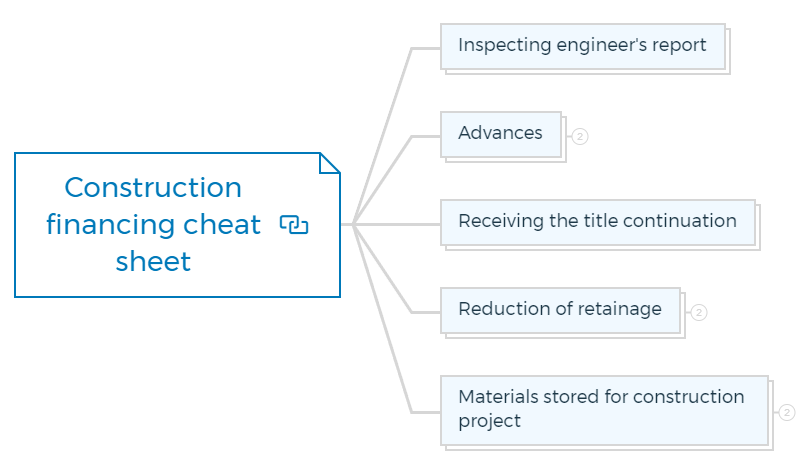
Inspecting engineer's report
The borrower will request that the lender's inspecting engineer visit the project to assess the work completed and confirm the presence of stored items a few days before or directly after a requisition filing.
After that, the engineer writes a report for the lender outlining what he observed, his concerns, and any ideas and suggestions he may have.
During his visit, he checks the status of the modifications made and the stored materials' type, quantity, and security.
They examine and frequently alter the amounts requested by the borrower and suggest funding the hard-cost amounts. Based on the current situation and the work made so far, they assess the project's potential for timely completion. Images should be there in the report.
It's critical to remember that the engineering consultant lacks all authority and capacity to make decisions or provide approvals that could bind the lender.
The lending officer is responsible for making all loan, credit, and administrative decisions, and senior management may also be involved, depending on his level of responsibility.
Advances
Construction loan funds are advanced to the borrower as construction progresses. The construction loan agreement will specify when and how construction advances are made.

Hard cost
A budget-line-by-budget-line basis is used to procure and advance hard costs, reflecting the legal contract between the owner or general contractor and each trade contractor.
It, in turn, affects the overall budget (including change orders) required to complete the project.
The hard cost to be advanced is calculated after adjusting the work accomplished and subtracting for retainage.
The consulting engineer is meant to have reviewed each hard cost line item for each request; thus, it is not the administrative person's responsibility to do this.
The administrative person's first duty is to cross-check the forms to ensure they add up and agree. They almost always are, but if they are not, the administrator must point out the errors and look into them.
The administrator may quickly identify variations by contrasting the current demand with the previously approved and financed one, especially if the borrower has made unforeseen adjustments to the budget.
He needs to call the borrower and get clarification if there are any unanswered questions.
It not only spares him the time he would have otherwise spent pondering paperwork, but it also informs the borrower or the staff member who created the request to approach things differently the next time to minimize misunderstanding and potential errors.
Soft cost
Because soft costs are typically not examined by the consulting engineer, they require more of the administrator's focus.
One line that is calculated and verified by the administrator is interest costs.
The time to obtain back proof of payment is typically after the requisition has been submitted. Hence, fees and expenses that may be verified with paid invoices and copies of checks are among the others.
Receiving the title continuation
The administrator must ensure that all monies advanced will continue to have a senior position about other claims after he is satisfied with the requisition package. The administrator checks to see if any liens have been posted by calling the title firm.
If liens have been posted, the title firm must bond, release, or insure them. Regardless of how the liens are handled, the administrator must be given a notice of title continuation or an endorsement of the title insurance policy.
Both of these must be dated as of the applicable advance date and state that there have been no changes to the title's status since the previous advance.
Reduction of retainage
Retainage is nearly always computed as a percentage of the hard costs that the borrower requested for the completed work.
It is customary to reduce the loan's hard cost retainage amount after a predetermined period or overall completion percentage to enable the borrower to pay off contractors who complete their work well before project completion.
Reaching a predetermined percentage of completion for the entire project and releasing retainage on a contractor-by-contractor basis are two methods frequently used to start a retainage reduction.

Percentage of completion approach
With the percentage of completion approach, a general decrease in retainage is permitted if the project completion reaches an overall percentage decided by the construction consultant.
This strategy gives the borrower some flexibility in negotiating and lowering the retainage under specific trade contracts.
Contractor-by-contractor approach
As mentioned in each construction contract, precise retainage reductions are typically reflected in the contractor-by-contractor approach's reductions.
In either case, as the project moves forward and different trades finish their work, the overall retainage amount that the lender is holding back won't decrease suddenly but will instead level out over time.
Please note that the decrease in retainage does not make more money accessible to the borrower. Instead, the lender's consulting engineer gives those payments directly to contractors who have finished their work.
Notably, the contractor should always be compelled to sign a lien waiver before any retainage decreases. Upon completion, the contractor must sign a final lien waiver before receiving the final payment that includes all retained funds.
Materials stored for construction project

On-site
For stored materials, there is a column on the continuation sheet. While some lenders permit advances for commodities in storage, others do not.
The disparity can be attributed to a few factors. The most evident is that unutilised or uninstalled building supplies may "walk" off the job site.
Another is that the developer might overorder items to earn a more significant advance; nevertheless, you can keep these materials on the site until the engineering consultant's inspection is finished. You then must redistribute the material to another site the borrower is building.
Other specific requirements include that the materials are clearly marked as the borrower's property, that the bills of sale and contracts under which they are being provided are acceptable to the lender and the construction consultant, and that they are insured against theft, loss, and casualty, that the lending institution is listed as a named insured, and that the borrower owns or will own the materials following the payment of invoices.
Off-site
You may be asked to fund materials that are not at the job site or maybe do not exist, in addition to the risks associated with funding materials for the job site.
Most of the time, such supplies come from vendors who demand deposits and down payments before ordering materials for fabrication or delivery or from specially fabricated components and assemblies produced off-site.
Before a lender funds off-site materials, there are typically more restrictions placed on their physical and financial security than on-site materials.
Many lenders include a provision for deposits and off-site materials when they draft the initial loan documentation. Other lenders' policies prohibit any financial assistance with deposits and stored goods.
Get The Edge Now!
Discover the transformative power of our FREE EDGE platform and
unlock a world of opportunities at no cost!

Your Real Estate Toolkit Awaits!
Free eBooks, Courses & Feasibility Suite Trial—Join Today!
✓ Unlimited FREE Trial: Experience the full power of our Feasibility Suite with hands-on demos
—explore without limits, no time pressure & without commitment or credit card!
✓ Learn from Success: Dive into real-life case studies for practical insights.
✓ Engage, Inquire, and Innovate: Ask questions, request features, and engage in lively discussions.
✓ Showcase Your Projects and Gain Insights: Share your projects and get personalised feedback.
✓ Free Resources Galore: Access a treasure trove of free resources,
eBooks & courses to keep you informed.
✓ Exclusive Training: Enjoy members-only training to sharpen your skills.
Project funding: overfunding vs underfunding
Lenders tend to underfund projects. This is expected given senior management's widespread aversion to risk at most lending institutions. Less money at risk equals less money advanced.
Regrettably, the caution that results in underfunding could make it riskier. Suppose a lack of funds forces the developer to be slow in making payments or to make only partial payments to contractors, municipalities, etc.
In that case, the project is more likely to be affected by delays, poor artistry, higher contractor and trade costs, fines and late charges, an increase in loan exposure resulting from a possible increase in the loan amount to cover budget overruns, delays in sign-offs, and ultimately nil completion.
In contrast, modestly overfunding requisitions can typically minimize risk since it can improve the likelihood that a project will be finished on schedule by streamlining the work process. A project is worth much more than one that is almost finished.

How to keep the loan in balance?
It simply implies that there is always enough money from equity and debt sources to finish the development as scheduled. This is known as keeping a loan in balance.
The loan is always out of balance whenever the development budget is short. If the borrower has enough equity and liquidity to invest more money in the project, overruns brought on by construction delays, replacing original materials or fixtures with more expensive ones, or poor judgment during the initial budgeting process are not a problem for the borrower.
However, there are situations when the borrower will argue with the lender's (or anyone else's) assessment that there are defects, even when it is evident there are. It is especially true if the borrower is undercapitalised.
He either does not have the luxury of spending more of his capital to finance the project in this instance, or he does not wish to do so.
Before approving an advance, the lending officer may consider requiring the borrower to invest the amount of the perceived deficiency in the project if the administrator, engineering consultant, or lending officer determines that the loan's allocation to a particular budget line is insufficient.
Suppose the administrator, engineering consultant, or lending officer determines that the portion of the loan allocated to a budget line is inadequate before an advance is approved.
In that case, the lending officer may require the borrower to invest the amount of the perceived deficiency in the project, change the budget line allocations by moving funds from areas where there appears to be an over budgeted line to the deficient line, or, in atypical cases, depo.
Deposits are disbursed based on requisitions. If the money deposited is more than needed or there are cost savings on other lines, the remainder might be returned to the borrower.
Bottom line
Although getting ready for the construction loan funding process first appears complicated, perplexing, dependent on numerous third parties, and rife with possible difficulties, it is a regular process that happens with every development loan.
Trusting others, to some extent, is the rule. No one can be thoroughly knowledgeable about the procedure, and even if there were such a person, it would be difficult for him to complete all the tasks simultaneously and promptly.
Because of this, the lender collaborates with many extremely skilled, knowledgeable, and certified individuals. Maintaining your composure at all times is a crucial requirement. Keep your attention on the task, heed counsel, and exercise good judgement.
Mastermind your next development project in just 30 Days with this property master course
FAQs

